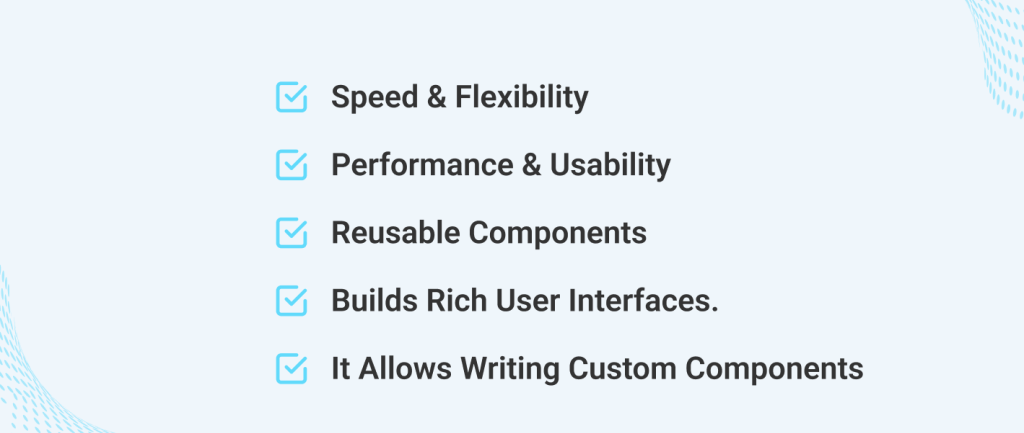React has become a popular and powerful JavaScript library in the field of frontend development. With its modular and component-based approach, React offers developers the advantage of building highly interactive and responsive user interfaces. This blog will explore why choose React for frontend development and the multitude of reasons behind its popularity. Primarily, React’s virtual DOM efficiently updates only the necessary components, resulting in improved performance and faster rendering.
Secondly, React’s reusable components enable developers to create a consistent and scalable codebase, reducing development time and effort. Moreover, React’s extensive ecosystem provides a wide range of libraries and tools, allowing developers to enhance their productivity and streamline their workflows. Additionally, React’s ability to seamlessly integrate with other frameworks and libraries further expands its capabilities.
Whether you’re an experienced developer or a beginner, choosing React for frontend development ensures a robust and efficient solution that meets the demands of modern web applications. So, if you’re looking for a framework that combines performance, scalability, and flexibility, React is undoubtedly the ideal choice.
Let’s dig into why you should choose React for frontend development. In this blog, you’ll explore the compelling reasons and advantages that make React a top choice for building powerful and efficient user interfaces. Discover how React can elevate your frontend development experience and unlock a world of possibilities for your web applications.
Advantages Of Using React For Frontend Development

React offers numerous advantages that make it a preferred choice for frontend development. Firstly, React’s component-based architecture allows developers to break down complex user interfaces into smaller, reusable components. This modular approach promotes code reusability, reducing redundancy and making the codebase easier to maintain. Additionally, React’s component-based architecture enables parallel development, where multiple developers can work on different components simultaneously, resulting in faster development cycles and improved productivity.
Another significant advantage of using React is its virtual DOM. The virtual DOM is a lightweight representation of the actual DOM, which allows React to efficiently update only the necessary components when there are changes in the application’s state. This means that React minimizes unnecessary re-rendering, resulting in improved performance and faster rendering speed. With React’s virtual DOM, developers can build highly responsive and interactive user interfaces that provide a seamless user experience.
Furthermore, React’s extensive ecosystem of libraries and tools contributes to its popularity. React has a vast collection of open-source libraries and community-driven tools that developers can leverage to enhance their productivity and streamline their workflows. Whether it’s state management with Redux, routing with React Router, or styling with CSS-in-JS libraries like styled components, React’s ecosystem provides a wide range of options to cater to different project requirements.
React Vs. Other Frontend Frameworks

While there are several front-end frameworks available, React stands out for its unique features and advantages. One notable difference between React and other frameworks is its virtual DOM. Unlike frameworks like Angular, which use a two-way data binding approach, React’s virtual DOM efficiently updates the UI by comparing the previous and current states of the application. This approach eliminates the need for manual DOM manipulation, resulting in improved performance and easier debugging.
React’s component-based architecture is also a differentiating factor. Unlike frameworks like Vue.js, which use a combination of templates and components, React relies solely on components. This makes React’s codebase more predictable and easier to understand, especially for developers who are new to the framework. Additionally, React’s component-based approach enables better code organization, reusability, and testability.
Another advantage of React is its lightweight and focused nature. React is primarily focused on the view layer of an application, which means it can be easily integrated with other libraries and frameworks. This flexibility allows developers to leverage the strengths of other technologies while still benefiting from React’s efficient rendering and component-based architecture.
React’s Component-Based Architecture

React’s component-based architecture is one of its defining features. In React, everything is a component, from simple UI elements to complex application views. This modular approach allows developers to break down the user interface into smaller, reusable building blocks, making it easier to manage and maintain the codebase.
Each React component encapsulates its own logic, state, and rendering, making it self-contained. This isolation ensures that changes in one component don’t have unintended side effects on other components. Additionally, React components can be composed together to create more complex components, facilitating code reuse and promoting a modular code structure.
React’s component-based architecture also promotes a clear separation of concerns. By separating the UI logic from the business logic, developers can focus on building reusable and testable components. This separation also enables parallel development, where different team members can work on different components simultaneously, resulting in faster development cycles.
Virtual DOM And Its Impact On Performance
React’s virtual DOM is a key feature that sets it apart from other front-end frameworks. The virtual DOM is a lightweight representation of the actual DOM, which React uses to efficiently update the UI when there are changes in the application’s state.
When changes occur in the application, React compares the previous and current states of the virtual DOM and determines the minimal set of changes required to update the actual DOM. This approach eliminates the need for manual DOM manipulation, which can be time-consuming and error-prone.
By minimizing the number of DOM updates, React improves the overall performance of the application. React’s virtual DOM efficiently updates only the necessary components, resulting in faster rendering and a smoother user experience. Additionally, React’s diffing algorithm optimizes the update process by identifying and applying only the necessary changes, further improving performance.
React’s Reusability And Scalability
One of React’s major advantages is its reusability and scalability. React’s component-based architecture allows developers to create reusable UI components that can be easily shared across different parts of the application. This reusability not only reduces redundancy but also promotes consistency and maintainability.
With React, developers can build a library of reusable components that can be quickly assembled to create new views or features. This modular approach significantly reduces development time and effort, as developers can leverage existing components instead of building everything from scratch.
React’s scalability is also worth mentioning. As the size and complexity of an application grow, React’s component-based architecture ensures that the codebase remains manageable and maintainable. The modular nature of React allows developers to isolate and test individual components, making it easier to identify and fix issues.
Furthermore, React’s ecosystem provides tools like React Router for managing application navigation and Redux for state management, enabling developers to handle complex scenarios with ease. With React’s scalability, developers can confidently build large-scale applications that can handle increasing user demands.
React’s Large And Active Community
React has a large and active community, which is another reason why it is a top choice for front-end development. The React community is vibrant and constantly evolving, with developers contributing to open-source projects, creating new libraries, and sharing their knowledge and experiences.
The active community ensures that React stays up to date with the latest trends and best practices. Developers can find a wealth of resources, including tutorials, documentation, and community-driven libraries, to help them learn and master React. The community also provides support through forums, chat groups, and social media, making it easier for developers to seek help and collaborate with others.
The large and active community also means that React is continuously improving and evolving. New features, performance optimizations, and bug fixes are regularly released, ensuring that React remains a robust and reliable framework for front-end development.
React’s Integration With Other Technologies
React’s ability to seamlessly integrate with other technologies is another advantage that sets it apart. Whether you’re using a different front-end framework, a back-end technology, or a third-party library, React can be easily integrated into your existing stack.
React’s lightweight and focused nature makes it compatible with a wide range of technologies. It can be used alongside frameworks like Angular or Vue.js, allowing developers to leverage the strengths of different frameworks while still benefiting from React’s efficient rendering and component-based architecture.
React can also be integrated with back-end technologies like Node.js or Django, enabling developers to build full-stack applications. This flexibility allows developers to choose the best tools for each part of the application and seamlessly connect them using React as the front-end framework.
Additionally, React has a vast ecosystem of libraries and tools that can be integrated into your project. Whether it’s for state management, routing, animation, or styling, React’s ecosystem provides a wide range of options to enhance your development workflow and accelerate your project’s progress.
Case Studies Of Successful Projects Using React

Numerous companies and organizations have successfully used React to build their applications. Let’s dig into how some successful companies used React for their respective platforms.
1. Asana
Asana is a popular project management software used by teams to track their work and projects efficiently.
They adopted React to enhance their user interface and improve user experience.
By leveraging React’s component-based architecture, Asana was able to create a modular and scalable codebase.
The use of React’s virtual DOM and efficient rendering helped Asana in achieving better performance and responsiveness in their application.
Asana’s decision to use React contributed to a smoother and more interactive project management experience for their users.
2. Atlassian
Atlassian is a leading software company known for its suite of collaboration and productivity tools like Jira, Confluence, and Trello.
They incorporated React into their products to modernize their front-end interfaces and ensure a more seamless user experience.
React’s component reusability and ease of maintenance allowed Atlassian to streamline their development process across multiple products.
By adopting React, Atlassian was able to stay ahead in the competitive software market and deliver user-friendly interfaces that resonated with their customers.
3. Dropbox
Dropbox is a widely-used cloud-based file-sharing and storage service. They integrated React into their web application to improve performance and enhance user interactions.
React’s virtual DOM and efficient updates helped Dropbox achieve a smoother and faster file browsing experience for their users.
The use of React components enabled Dropbox developers to build a consistent and responsive user interface across different devices and browsers.
React’s ability to handle complex interactions and data changes made it a suitable choice for Dropbox to deliver a reliable and user-friendly file-sharing platform.
4. Discord
Discord is a popular communication platform primarily used by gamers for voice, video, and text chat during gaming sessions. They chose React to develop their web and desktop applications for its performance and scalability advantages.
React’s virtual DOM and optimized rendering enabled Discord to maintain a responsive chat interface, even in large communities with heavy concurrent usage. By utilizing React components, Discord ensured a consistent and customizable user interface for their diverse user base, ranging from gamers to communities and businesses.
In summary, each of these companies embraced React for its capabilities in building interactive and high-performance user interfaces. By leveraging React’s component-based approach, virtual DOM, and efficient rendering, they were able to create more engaging and scalable applications, leading to improved user experiences and customer satisfaction.
Final Thoughts On Why Choose React for Frontend Development
React offers a multitude of advantages that make it a top choice for front-end development. Its component-based architecture promotes code reusability, scalability, and maintainability, which is why choose React for frontend development. The virtual DOM efficiently updates the UI, resulting in improved performance and faster rendering. React’s extensive ecosystem provides a wide range of libraries and tools, enhancing developer productivity. Its seamless integration with other technologies makes it flexible and compatible with different stacks. The success stories of companies like Discord, Dropbox, Asana, and Atlassian further highlight the capabilities of React.
React’s combination of performance, scalability, and flexibility makes it the ideal choice for building highly interactive and responsive user interfaces. Embrace React and unlock the potential to create exceptional web experiences.
Choose Aipxperts For Your React Development Needs!
Take your web development to the next level with Aipxperts team of expert React developers! Why choose React for frontend development? Our developers are proficient in creating robust and efficient web applications that cater to your unique requirements. From crafting dynamic websites to delivering scalable web solutions, our expertise in React ensures a smooth development process and exceptional outcomes for your projects. Partner with Aipxperts to transform your ideas into reality and elevate your web development to new heights!
Why Choose React for Frontend Development? | Choose top-notch React development services with Aipxperts. Contact us for project estimates and enjoy a 15-day risk-free trial period.











